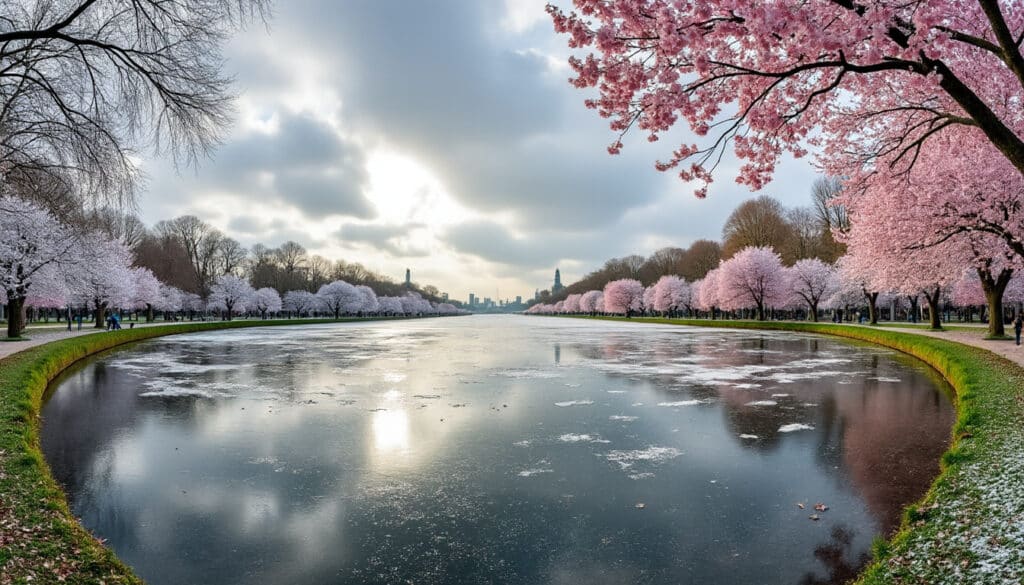The city of Berlin, capital of Germany, boasts a rich tapestry of culture and history, but many might not realize the weather here is just as compelling. Situated at a latitude of approximately 52 degrees north, Berlin experiences a moderately continental climate. This means residents and visitors alike are treated to a colorful array of temperatures throughout the year. From the chilly embrace of winter to the warm caress of summer, temperatures in Berlin add a unique layer to the city’s vibrant atmosphere.
Understanding the Seasonal Temperature Variations
The diversity of temperatures in Berlin is shaped by its unique climatic conditions. Winters in Berlin are known to be cold, often dipping to average lows around 0°C (32°F). However, it is not uncommon to encounter freezing nights where thermometers can plunge well below this figure. The chilly Berlin air, affectionately referred to as “Berliner Luft”, wraps the city in its wintry embrace, offering a magical snowy landscape.
On the opposite end of the spectrum, summers in Berlin present a stark contrast. Daytime temperatures generally hover around a comfortable 25°C (77°F), making it a delightful time for outdoor activities and immersing oneself in the city’s dynamic outdoor events. There are days, however, when the temperature can climb higher, leading to what many describe as a “Heatwave Berlin.”
The transitional seasons, spring and autumn, bring their own charm. In spring, temperatures rise gradually from the frosty grip of winter, usually ranging from 10°C to 20°C (50°F to 68°F) in April and May. Autumn mirrors this transition in reverse, with temperatures slowly tapering off as winter approaches.

The Impact of Wind and Humidity
The effects of Berlin’s temperatures are often intensified by wind and humidity, elements that can either add to the chill or enhance the warmth of a day. During winter, winds often blow from the northeast, bringing colder air from the continental interior. This aspect is something to consider when planning outdoor excursions during the colder months. In contrast, the warmer months see a shift in wind direction, predominantly coming from the west, which brings milder and more humid air, often enhancing the feeling of warmth.
Humidity in Berlin tends to be quite variable. In the summer months, the humidity can add to the sensation of heat, while in winter, drier air can make the cold feel even crisper. Understanding how these factors play into the overall climate is essential for planning one’s wardrobe or travel itinerary accordingly.
How Berlin’s Climate Influences Daily Life
The “Berlin Climate,” with its diverse weather patterns, greatly influences the lifestyles of those who live there, as well as visitors. Many cultural events are tailored to the seasons; for instance, winter is synonymous with Christmas markets and ice-skating rinks dotting the city. Residents and tourists alike revel in the festive atmosphere despite the cold.
In summer, the parks and open spaces of Berlin come alive. The banks of the River Spree and the numerous lakes around the city become popular spots for relaxation and recreation. The pleasant “Sunny Berlin” days encourage outdoor festivals, open-air concerts, and a bustling cafe culture. The balance between cold and warm days ensures there is always something suitable to do, no matter the weather.
- Winter Activities: ❄️ Ice skating, Christmas markets, cozying up in cafes
- Spring Blossoms: 🌸 Cherry blossom viewing, cycling tours
- Summer Fun: 🌞 Beach bars along the Spree, music festivals
- Autumn Colors: 🍂 Hiking in the surrounding forests, enjoying autumnal foliage
By integrating the myriad of temperatures into the fabric of daily life, Berlin creates an ever-changing palette of experiences. Understanding the local weather is not just about knowing whether to wear a coat or shorts, but about preparing to engage with the city in all its seasonal glory.
The Influence of Climate on Urban Planning
Urban planning in Berlin takes heavy cues from its climatic conditions. Seasonal temperature variations influence everything from heating requirements in buildings to the design of public spaces. In the colder months, efficient thermal insulation becomes essential to cope with “Chilly Berlin” days, while during the summer, shaded areas and cooling urban designs help mitigate the heat.
Moreover, transportation infrastructure is also adapted with these climate variations in mind. The extensive public transport network is resilient against harsh winters, while in the summer, air-conditioned buses and trams provide a respite from the heat. We see these aspects in play in the city’s architectural designs, ensuring all-year-round comfort.
- Building insulation for winter ❄️
- Shaded pavements and green spaces for summer 🌳
- Public transport adaptations 🚋
Navigating Through Temperature Extremes
Berlin is not immune to weather extremes which can range from unexpected heatwaves to intense snowfalls. Weather events such as a sudden “Heatwave Berlin” can catch both residents and tourists off guard. Understanding how to manage and adapt to these extremes is crucial for an enjoyable experience.
One of the ways Berliners deal with heatwaves, for instance, is by frequenting the various outdoor swimming pools and lidos that the city offers. These become popular retreats when the “Berlin Thermals” push the mercury up. Conversely, during intense snowfalls, the city is well prepared with efficient snow clearance and public advisories to ensure safety and accessibility.
Preparation tips for visitors:
- For heatwaves: 🏊♀️ Check out the outdoor pools and ensure to hydrate
- For snow: ❄️ Wear layers and check transport alerts
| Extreme Condition | Preparation | Activities |
|---|---|---|
| Heatwave | Hydration, light clothing | Pool visits, indoor museums |
| Snowfall | Warm clothing, check transport | Skiing, snowball fights |
FAQs on Berlin’s Temperatures
- What is the coldest month in Berlin? The coldest month is typically January, with temperatures often dropping to around freezing, but can feel much colder with the wind chill.
- Is Berlin a rainy city? Berlin does experience rainfall year-round but is not particularly known for heavy precipitation; summers especially tend to have lighter showers.
- How do residents cope with heat in summer? Air conditioning is not as common in Berlin’s residential areas; fans and natural ventilation methods are commonly used, alongside visits to lakes and pools.
- Does it snow in Berlin? Yes, snow is a regular feature in Berlin’s winters, contributing to the city’s winter wonderland atmosphere.
- What should travelers pack for Berlin’s climate? Layered clothing is key, as temperatures can vary widely, particularly during transitional seasons.

Navigating the climate in Berlin involves understanding its unique variations across the seasons. The city, known for its cultural vibrancy and historical significance, experiences a maritime temperate climate that influences both residents and tourists. Whether you’re strolling the streets of…

As winter descends upon Berlin, the city’s vibrant streets transform into a mystical canvas painted with frosty hues. Locals and visitors alike brace for the biting chill, exploring unique ways to embrace the city’s cold climate. From cozy cafés to…

Flooding and natural risks in Berlin
The vibrant city of Berlin, known for its rich history and dynamic urban culture, faces its share of natural challenges, particularly flooding. With its intricate network of rivers and canals, Berlin’s flood risks have increasingly become a focal point for…

Berlin, the vibrant capital of Germany, is no stranger to fluctuating weather patterns. As summer approaches, it transforms into a bustling hub where residents and tourists alike bask in the warmth of the season. With its distinct urban culture and…

Is Berlin warm throughout the year?
Berlin, the bustling capital of Germany, is a city rich in history, culture, and diverse climate patterns. As a key player in the cultural and political landscape of Europe, understanding Berlin’s weather throughout the year is crucial for both residents…

Rain and precipitation in Berlin
Berlin, well-known for its rich historical and cultural heritage, is also characterized by its distinct climate patterns. The city receives an average of 591 mm of rainfall annually, making rain and precipitation a significant aspect of life here. This article…

In Berlin, the allure of a new day begins with the gentle rise of the sun, casting its warm glow over the city’s iconic skyline. The sunrise times in this vibrant metropolis not only mark the beginning of a new…

Berlin, with its vibrant culture and rich history, attracts millions of tourists each year. A key factor to consider when planning your visit is the weather, which shifts dramatically from month to month. This article provides an in-depth look at…

What is the weather like in Berlin?
Berlin, the vibrant capital of Germany, is known not only for its rich history and dynamic cultural scene but also for its unique weather patterns that can vastly vary throughout the year. Whether you’re a resident soaking in the Berlin…




